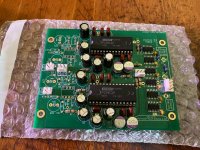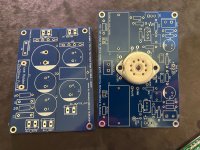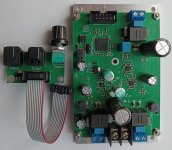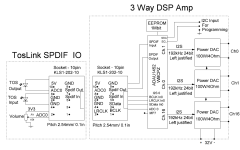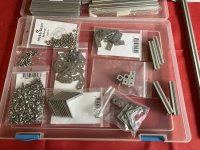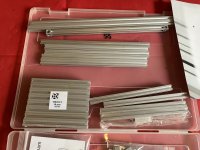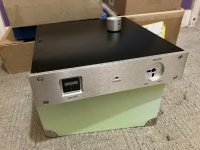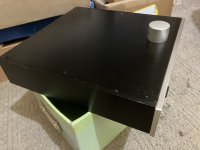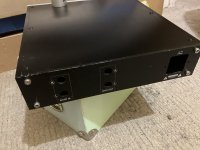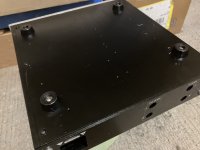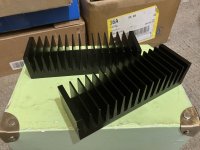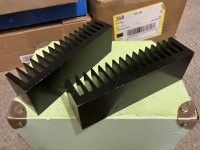At this time all the boards are sold out!
This is a group buy for a set of input and switch boards for the
Soekris DAM1021 DAC.
Documentation can be downloaded here (PDF on Google Drive).
The Gerber files for the latest versions of the boards are posted in
#580.
The schematics for input and switch boards are posted in
#332.
Schematic and PCB design for a power supply are posted in
#325.
More information about the muting module can be found in posts
#237,
#259 and
#263. The schematic is posted in
#262. Muting boards are now sold out. Gerber files for making your own boards are posted in
#454.
Input board BOM:
https://docs.google.com/spreadsheets/d/1ENt40kTZhL9ITpYthZ8c4qUfL6y8ajTpFsxg7ic-8vU/edit?usp=sharing
Switch board BOM:
https://docs.google.com/spreadsheets/d/1gz4L44eWwEkDHWcEnBIwdIYa3pOwWgeSbLcd3dcf6AY/edit?usp=sharing
Muting board BOM:
https://docs.google.com/spreadsheets/d/1mkKxl3J7ERI1Ij2h5PFqQ5qZ6s5hMIRs1WoFZ5Vm1gg/edit?usp=sharing
The default RPi connector PCB for V2 boards is designed for Raspberry Pi 2 and B+ models. If you are interested in connectivity for older Raspberry Pi A/B models or Arduino, and have not indicated it on the original signup sheet, please post on the thread.
Pricing:
Input board bare PCB: Sold out
Switch board bare PCB: Sold out
Assembled input board kit: Sold out
Assembled switch board kit: Sold out
Additional input board parts for balanced build: 5 EUR
Shipping anywhere in the world: 9 EUR
Assembled muting board kit: Sold out
Additional muting board parts for balanced build: Sold out
Input V2 features
- Stacks on top of DAM1021.
- Directly connects to J3 and J2 headers on the DAC without additional cabling.
- Directly connects to Amanero USB adapter without additional cabling.
- Directly connects to DIYINHK USB interface (the non-isolated version) without additional cabling.
- Easy ribbon cable connection to WaveIO USB interface.
- Directly connects to Raspberry Pi without additional cabling.
- Additional connector PCBs can be designed to use other microcontrollers such as Arduino, BeagleBone Black, etc.
- Can be controlled using the isolated serial port.
- Serial port control from Raspberry Pi.
- Coaxial SPDIF input with BNC connector footprint.
- Optical TOSLINK input with footprints for Toshiba TORX147L and Cliff Electronics ORJ-5 receivers.
- U.FL sockets for other I2S sources (can be installed, but not used simultaneously with Amanero/DIYINHK).
- Optional U.FL sockets for Amanero MCLK OUT, I2S MCLK OUT, FPGA SLV and FPGA MCLK OUT lines.
- External connections possible to ALL pins on DAM1021 J2 and J3, and to Raspberry Pi GPIO connector.
- Two selectable I2S inputs.
- Built-in regulated power supply for the isolated digital part/muting module/USB/RPi/other microcontrollers.
- Amanero/DIYINHK USB status lines readable from Raspberry GPIO pins. WaveIO USB status lines can also be connected by manual wiring.
- Supports true balanced configuration with two DAM1021 DACs. A single input board is needed for dual-DAM balanced build.
- For true balanced configuration the second DAM1021 stacks directly on top.
- Supports serial port chaining for true balanced configuration.
- Supports separate access to each serial port for true balanced configuration.
- EMI filters on I2S lines to reduce high frequency noise pollution.
Switch V2 features
The switch board allows DAM1021 input selection and volume adjustment by use of mechanical switch and potentiometer. It is not required if DAM1021 will be controlled exclusively by a microcontroller via serial port.
- Includes a rotary switch for input selection
- Input selections are "Auto", "TOSLINK", "COAX", "I2S-1" and "I2S-2".
- Allows connecting a potentiometer for volume control.
- Footprints for front panel indicator LEDs for DAM1021 POWERLED and input selection.
- Includes ribbon cable for easy connection to the input board.
- Supports true balanced configuration with two DAM1021 DACs. A single switch board is needed for dual-DAM balanced build.
- It is an optional accessory for the input board and is not useable separately.
Muting board with alternative output buffer option.
Muting is done by shunting the unbuffered outputs to ground with normally closed relay contacts. When the relay turns on, mute is off. Since the DAM1021 pin18 muting control does not work properly as of the current firmware release, and it can be quite difficult to attach wiring directly to that pin, the mute control is implemented independently.
- Stacks directly onto DAM1021 J7 header (the unbuffered outputs).
- Fits even with the onboard XLR connectors mounted (although I do not recommend using them).
- Power-on muting uses a delay circuit which turns on the outputs approximately 8 seconds after power is applied.
- Power-off muting uses AC detection and will mute the outputs within approximately 30 ms after loss of AC power.
- Optionally these timer based circuits can be bypassed and pin18 driven control can be implemented.
- Includes PCB footprints for implementing SE to balanced output buffers using THAT1646/DRV134 chips using easy to solder through hole parts.
- Supports true balanced configuration with two DAM1021 DACs. A single muting board is needed for dual-DAM balanced build.
- Includes PCB footprints for implementing true balanced output buffers using THAT1606 chips (only available in TSSOP-16 packaging, quite fine pitched SMD parts).
- For true balanced configuration the second DAM1021 stacks directly on top.
It should be possible to use the balanced unbuffered hardware setup for a 2-way crossover in single ended mode, although it has not been tested.
This wiki page contains documentation for the old V1.1 release of the input board.
